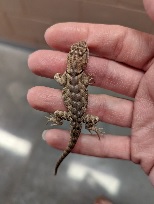Yellow-Backed Spiny Lizard (Sceloporus uniformis)
Description: S. uniformis is a large robust lizard, and adults can grow to 5.5 inches in body length (snout-to-vent), with a tail slightly longer than the body. Color is brown or tan with yellow and black dorsal stripes or mottling and a black collar on the sides of the neck.
Males are larger than females, and have a swollen tail base, enlarged postanal scales and femoral pores, and bluish markings on the throat and belly. Females have a pale throat and underbelly, with faint or no blue markings. The head of a female may be orange or reddish in the breeding season.
Habitat: This lizard inhabits arid and semiarid regions, from plains to lower mountain slopes, including desert shrubland and woodland, mesquite-yucca grassland, juniper and mesquite woodland, shrubby areas along arroyos, and cottonwood/willow zones along rivers (Hammerson 1999, Stebbins 2003). It occurs on trees, rocks, and on the ground near cover. Eggs are laid in soil/underground.
Range: Range has not been precisely circumscribed but includes California, Nevada, Arizona, and Utah.
Found in these States:
CA |
AZ |
NV |
UT
Diet: This species will eat a variety of small invertebrates and their larvae including ants, beetles, grasshoppers, spiders, centipedes, and caterpillars. Occasionally, small lizards, nestling birds, leaves, flowers and berries are also consumed.[3]
Reproduction: Adults are sexually mature at 2 - 3 years. Mating occurs in spring and early summer, generally May and June sometimes until August.
Females lay a clutch of 3 - 19 eggs between May and August. During favorable years they may lay more than one clutch. Young are typically seen in August and September, sometimes October.
Status: This species is represented by many hundreds of collection sites. The total adult population size is unknown but certainly exceeds 100,000. The extent of occurrence, area of occupancy, and population size are large and relatively stable. Common in Mexico.
Taxonomy: Sceloporus uniformis was originally described as a subspecies of Sceloporus magister in 1955. In 2006, genetic analysis revealed that S. uniformis is sufficiently distinct to merit classification as its own species. Sceloporus magister and Sceloporus uniformis were once considered the same species, and some herpetologists still consider this to be true. The appearance of both species is so similar that it is difficult to tell them apart.
»» Kingdom: Animalia - Animals
»» Phylum: Chordata - Chordates
»» Subphylum: Vertebrata - Vertebrates
»» Class: Reptilia - Reptiles
»» Order: Squamata - Lizards
»» Family: Phrynosomatidae - North American Spiny Lizards
»» Genus: Sceloporus
»» Species: Sceloporus uniformis - Yellow-Backed Spiny Lizard
»» Subspecies: None
This article uses material from the Wikipedia article "Sceloporus uniformis", which is released under the Creative Commons Attribution-Share-Alike License 3.0. Content may have been omitted from the original, but no content has been changed or extended.
|








